PHOENIX — In the Sonoran Desert, there are few animals that are so simultaneously beloved and elusive as the iconic, venomous Gila monster.
Since they spend the vast majority of their lives underground, we don't actually know very much about the species. Their habits and needs in the wild aren't well studied, simply because they're really good at avoiding us. But Arizonans love their lizards and in 2016 people from across the state came together to crowdfund a nearly decade-long project to uncover the most fundamental secrets of the Gila monster.
Now, in 2024, Arizona State University evolutionary biologist Melissa Wilson saw her work and the community's support come to fruition. Funded by over $10,000 in donations from people around the state, she and her team were the first ones to fully sequence the genome of Arizona's favorite reptile.
>> Live, local, breaking. Download the 12News app
"It's one of these projects that all of the people invested in it thought it was a good idea, but we couldn't get it funded externally," Wilson said.
After multiple funding requests were rejected by the National Science Foundation, Wilson and her team turned to crowdfunding. The results were overwhelmingly positive.
"The biggest difference is that it's been really nice to have a dialogue with people who are motivated about it," she said. "Generally, our research is funded by foundations or the federal government. It's still individuals but we don't have the same sort of connection where we can talk to people and get to feel their excitement about the project and what we're doing."
The research behind the reptile
But wait, you might ask, what does "sequencing the genome" even mean?
Genome sequencing is the process of determining the entire, or nearly the entire, DNA code of an organism all at once. It lays out the full genetic "instructions" needed for that organism to function, grow and exist.
It's not easy work; we've only done it for about 15% of known mammal species and around 1.2% of known scaled reptile species. Even if the tech to do it is getting better, it's not cheap and it takes a lot of manpower. Not only do researchers need to physically extract microscopic strands of DNA, they need to analyze how those genes work in the organism. Make sense?
Let's get back to Gila monsters. Other than them being adorable bundles of desert goodness, why did they bother with the effort?


For Wilson, it's easy: "Medical relevance to humans." It turns out that Gila monsters create a molecule in their saliva that we make in labs to help treat type 2 diabetes — Glucagon-like peptide-1, if you want to Google it.
"Ideally, probably the molecule does the same thing. But why do they have it?" Wilson asked, "Now that we have a reference genome, we can start to compare with other species and see where this gene came from. What is its evolutionary history? When did it pop up in time? Was it when they started living in the desert? Maybe it has something to do with their adaptation to reduced water and reduced food availability... It's questions we can answer now."
However, Wilson, who runs the Sex Chromosome Lab at ASU, wants to understand what determines whether Gila monsters are male or female. While mammals are pretty consistent — females tend to have XX chromosomes, males tend to have XY — reptiles aren't.
Some reptiles have an XX/XY system like mammals, but others like the Gila monster buck that for Z and W sex chromosomes. In the case of Gila monsters, even the typical male/female pairings are reversed.
"[Unlike mammals] it's the egg carriers that have a large Z chromosome and a small, degraded W which is similar to the Y chromosome in humans," Wilson explained. "The males, the sperm producers, produce everything with [two] Z chromosomes. They don't have a W at all. So it's exactly the opposite system of us."


>>Editor's note: The top right image above is a logo drawn for the project.
Wilson stressed that because of these differences, we know that sexual determination evolved way before the specific shapes and arrangements of our chromosomes. It's determination pathways — the sets of genes that activate in concert together — that make a difference in determining male or female. Not, necessarily, which chromosomes are present in the individual.
For now, Wilson and her team have only sequenced the genes of a male Gila monster — the ZZ one. The process took eight years in total as they grappled with securing funding and getting new technology. But she's thrilled to say that sequencing female Gila monster DNA could be done much sooner.
"I am wildly excited that we're going to get the W chromosome in a female," she said.
Until recently, research almost always focused on the sex with paired chromosomes like XX or ZZ. The W and Y chromosomes are much smaller (as much as 90% smaller in humans) and physically harder to study. But new tech is opening those possibilities.
"If we don't have it by the end of the summer, I will be distraught!" Wilson said with a smile. "But I imagine we'll have it within the next month."
For now, you can stay with 12News to learn what they uncover about our elusive Gila monsters once the project is complete.
>> Download the 12News app for the latest local breaking news straight to your phone.
WE ❤ ARIZONA
Explore amAZing people, places and things across our state on our 12News YouTube playlist here.



